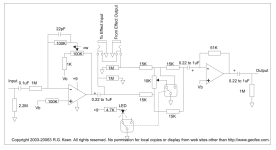benny_profane
Well-known member
I'm looking to adapt the RG Keen "Panning for Fun" circuit for a project. I had some questions about the first op-amp stage of the 'high-impedance' version.

First, is the first op-amp being used as a differential amplifier? If so, this means that the typical inverting op-amp calculations don't apply here. Second, what is the purpose of the 100k resistor between Vb and the non-inverting input? Does this affect the voltage divider resistor network used to create Vc/2 for a single supply? Third, why is Vb connected to the feedback loop through the 1k resistor to the trimmer?

First, is the first op-amp being used as a differential amplifier? If so, this means that the typical inverting op-amp calculations don't apply here. Second, what is the purpose of the 100k resistor between Vb and the non-inverting input? Does this affect the voltage divider resistor network used to create Vc/2 for a single supply? Third, why is Vb connected to the feedback loop through the 1k resistor to the trimmer?

